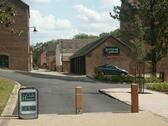Reynolds Wharf
Region: West Midlands
Unitary Authority: Telford and Wrekin
Owner Type: Private
Funding Body: Private sector scheme, Derelict land grant
Summary: By adopting a pro-active approach to the development of the Reynolds Wharf site a very high quality housing development has been achieved within a World Heritage site location. A combination of techniques such as a design brief coupled with partnership working and public involvement has contributed to this.
The Reynolds Wharf site lies in the settlement of Coalport, in the south of Telford in Shropshire. It is within the Severn Gorge Conservation Area and Ironbridge Gorge World Heritage Site (WHS). The WHS was designated by UNESCO in 1986 for its cultural significance with regard to industrial archaeology, historic character and natural environment.
In its heyday, in the mid 19th century, the site was used for unloading of China Clay from the River Severn and Wharfage and for transporting finished goods from the Coalport China Factory. In the 1920’s, it became the base for the Nuway Rubber Matting Company.
When it became redundant in the late 1980’s, the site was heavily contaminated and was also the subject of fly tipping. It was eventually acquired by the Ironbridge Gorge Museum Trust (IGMT) who operate the nine Industrial Museums of the Heritage Site.
The site was hazardous to public safety and was a derelict eyesore that blighted the important adjacent Museum site and the World Heritage Site, despite containing a Grade II listed building and another building of local interest.
Following a public meeting in 1996, IGMT appointed consultants to prepare a brief for the development of the site with the Council providing guidance on planning issues. The principles of the Brief were endorsed by Planning Committee in 1998 and IGMT then appointed the Edward Nash Partnership to secure planning permission for the site.
Planning permission was granted in 2000 and the chosen developer was Shropshire Homes who sought further refinement to the approved scheme.
Whilst the site was situated within an area of historic interest and internationally important heritage, where a local vernacular of general architectural form and design can be established, it was essential to ensure that the development resulted in added value through the interpretation of the place as well as providing appropriate forms of buildings and space with very high quality detailing.
The Borough Council has played a key role in promoting the site for development over a number of years. The allocation of the site within the Wrekin Local Plan was key to its development and planning officers have, over the course of 8-10 years, offered advice and guidance to all parties. Funding was also secured through the derelict grant programme to carry out site investigations of the contaminated site.
It was essential to ensure that the development resulted in not just physical benefits for the site and Conservation Area/WHS, but also social and environmental benefits for the local community. Such benefits have been secured through a legal agreement with the Museum.
The development of the site was contentious within the local area and the Council acted as facilitator and chair for a number of public meetings to discuss the development of the site, both at pre-application stage and as part of the consideration of the submitted proposals.
It was essential to consider the proposals objectively and to be impartial whilst co-ordinating the aspirations of the Museum and developer with the concerns and requirements of the local community and other important consultees such as English Heritage and the Environment Agency. The development is the result of a considerable amount of effort and commitment from all of those involved. It has taken time, patience and care to bring about the high quality solution that we see today.
Importantly, partners agreed that the original architect should be retained as advisor to the chosen developer to ensure that the built form was consistent with the approved scheme and, in conjunction with the planning officer, to provide a cohesive link to the work previously carried out.
The aims of all partners have been consistent and, with the guidance of the Local Planning Authority, have resulted in a very high quality form of development that we see today.
The Reynolds Wharf development has been instrumental in informing the local community and bringing about important social and community benefits. Access and interpretation of the adjacent Coalport China Museum, former canal route and historic industrial context provide a very high quality environment that will enhance the area and WHS for both the local community and those visiting the area.
The development is a splendid example of building in context, providing:
- 42 high quality new homes including the conversion and re-use of a listed building and two other historic buildings
- contamination remediation
- significant improvements to the Museum car park
- supporting and creating new community facilities, including play areas
It provides a particularly successful model of how historic buildings can be retained and re-used within a wider development scheme and how the use of 'non-standard' solutions can bring about additional quality to a development.
The development principles, interpretation of context and relationship between buildings and use of space will all serve as a model for any future development, not just within the Conservation Area/WHS, but the Borough as a whole. Furthermore, the development could inform future proposals for development on a regional and national level, particularly in a heritage context.
Keywords: Design in Context; Regeneration; Re-use

